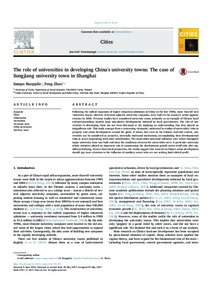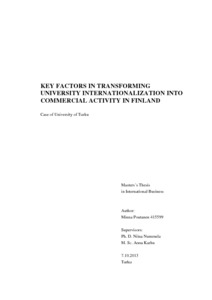A COMPARATIVE STUDY ABOUT PERCEPTIONS OF TEACHING METHODS AMONG UNIVERSITY STUDENTS IN FINLAND AND GERMANY : A CASE STUDY OF THE UNIVERSITY OF TURKU AND THE UNIVERSITY OF REGENSBURG
Oyedayo, Oyeleye (2019-03-15)
A COMPARATIVE STUDY ABOUT PERCEPTIONS OF TEACHING METHODS AMONG UNIVERSITY STUDENTS IN FINLAND AND GERMANY : A CASE STUDY OF THE UNIVERSITY OF TURKU AND THE UNIVERSITY OF REGENSBURG
Oyedayo, Oyeleye
(15.03.2019)
Julkaisu on tekijänoikeussäännösten alainen. Teosta voi lukea ja tulostaa henkilökohtaista käyttöä varten. Käyttö kaupallisiin tarkoituksiin on kielletty.
suljettu
Julkaisun pysyvä osoite on:
https://urn.fi/URN:NBN:fi-fe2019040811473
https://urn.fi/URN:NBN:fi-fe2019040811473
Tiivistelmä
The present study investigated students’ perceptions about teaching methods in the
University of Turku (UTU), Finland and the University of Regensburg (UR), Germany.
The objective was to investigate the differences and similarities between their
perceptions. Most previous studies focused on university teachers’, not students’
perceptions, about teaching methods. The purpose of the study was to investigate whether
discrepancies existed between students’ perceptions and literature. Data was collected by
administering 220 questionnaires to the bachelor’s and master’s degree Education
students, using a convenience sampling technique. In total, 216 were retrieved, while 199
were valid for the study, where 87 (44%) and 112 (56%) were from UTU and UR,
respectively. Quantitative research design was adopted. The reliability of the instrument
was determined, using cronbach alpha coefficient for student-centred method scale
(r=.74), teacher-centred method scale (r=.64) and teacher-student interactive method
scale (r=.80). The data was grouped, using factor analysis. Descriptive statistics of
frequency counts and simple percentage was used for the demographic data section. Ttest
was used to analyze the similarities and differences between students’ perceptions,
for other sections addressing the three teaching methods. Based on students’ perceptions,
their teachers predominantly used student-centred method, occasionally used teachercentred
method, but slightly disagreed that they used teacher-student interactive method.
Additionally, using .05 significant level, there was significant difference between their
perceptions about teacher-centred method (p=.01), while student-centred (p=.13) and
teacher-student centred methods (p=.86) recorded no significant difference.
University of Turku (UTU), Finland and the University of Regensburg (UR), Germany.
The objective was to investigate the differences and similarities between their
perceptions. Most previous studies focused on university teachers’, not students’
perceptions, about teaching methods. The purpose of the study was to investigate whether
discrepancies existed between students’ perceptions and literature. Data was collected by
administering 220 questionnaires to the bachelor’s and master’s degree Education
students, using a convenience sampling technique. In total, 216 were retrieved, while 199
were valid for the study, where 87 (44%) and 112 (56%) were from UTU and UR,
respectively. Quantitative research design was adopted. The reliability of the instrument
was determined, using cronbach alpha coefficient for student-centred method scale
(r=.74), teacher-centred method scale (r=.64) and teacher-student interactive method
scale (r=.80). The data was grouped, using factor analysis. Descriptive statistics of
frequency counts and simple percentage was used for the demographic data section. Ttest
was used to analyze the similarities and differences between students’ perceptions,
for other sections addressing the three teaching methods. Based on students’ perceptions,
their teachers predominantly used student-centred method, occasionally used teachercentred
method, but slightly disagreed that they used teacher-student interactive method.
Additionally, using .05 significant level, there was significant difference between their
perceptions about teacher-centred method (p=.01), while student-centred (p=.13) and
teacher-student centred methods (p=.86) recorded no significant difference.
Samankaltainen aineisto
Näytetään aineisto, joilla on samankaltaisia nimekkeitä, tekijöitä tai asiasanoja.
-
The role of universities in developing China's university towns: The case of Songjiang university town in Shanghai
Sampo Ruoppila; Feng Zhao<p> Following the radical expansion of higher education admission in China in the late 1990s, more than 60 new ‘university towns’, districts of several adjacent university campuses, were built in the country's ... -
Key factors in transforming university internationalization into commercial activity in Finland. Case of University of Turku
Poutanen, Minna (07.10.2013)Globalization, developments in ICT, emergence of knowledge society and other changes have reformed the environment for international higher education during the past few decades. Consequently, higher education sector has ...avoin -
University Engagements and Regional Specialisation – Comparative case study on regional engagements of universities in Finland and Sri Lanka and lessons learned
Sidath, Alwis (Turun yliopisto. Turun kauppakorkeakoulu, 19.09.2016)Finland is considered among the first countries that adopted the national innovation system (NIS) framework as the foundation of their science and technology policy. Being a part of Finnish NIS framework, Finnish universities ...

